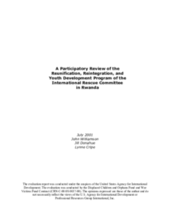The genocide, population displacements, and armed conflict in Rwanda gave rise to unprecedented numbers of children separated from their families. By April 2001, some 3,700 children remained in 28 centers for separated children. The Ministry of Local Administration and Social Affairs (MINALOC) is responsible for monitoring these centers, but its capacity to do so is very limited, and it does not have a set of legal standards to use in assessing the adequacy of the care provided in these centers. Problems are beginning to emerge in these centers, particularly among young people in late adolescence. Often these young people do not fit in anywhere other than the institution because they have been isolated from the surrounding community. In addition to children in centers, other Rwandan children who are particularly vulnerable include street children, children in households headed by a child, children orphaned or otherwise affected by HIV/AIDS, and children whose parents are in prison.
Although some recent progress has been made, the Rwandan economy remains very weak, and opportunities for individuals and households are quite limited. Several organizations are engaged in activities to improve the economic situation of poor households.

